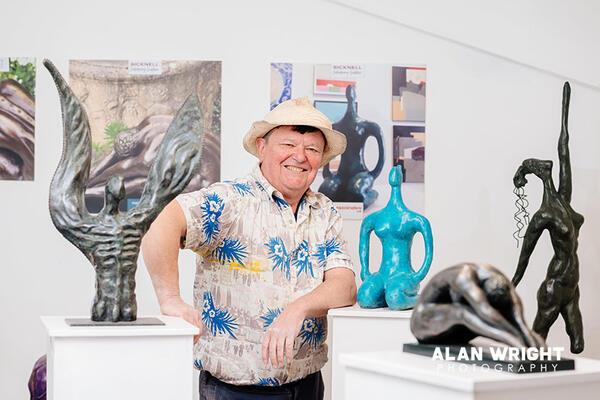Sculptor Steve Bicknell

Published: 1st May 2022
Steve Bicknell worked as a professional photographer before finding further success in publishing, specialising in calendars and children’s books. In recent years, he has pursued a passion for sculpture, working from a studio in Thakeham. Here, Steve describes his artistic journey and the concepts behind his thought-provoking work….
Creating a Vision
We were downsizing to a cottage which needed extensive work. I worked closely with the builders, project managing the entire renovation, and enjoyed myself immensely, especially when it came to landscaping the garden. I had a vision of what I wanted and that included a sculpture amongst the trees. I searched online but couldn’t find the right piece. During the renovation, I helped make concrete worktops and had loved the visual impact of the material. So, I decided to make my own sculpture using similar materials.
Trial & Error
I jumped straight in at the deep end and created a large conceptual piece of art. Being self-taught, the process involved a lot of trial and error. To begin with, I needed a metal frame, so I contacted local blacksmiths. The Iron Lady at Bradwell Blacksmiths in Angmering immediately engaged with my ideas and gave me a better understanding of what was possible. I started making small test pieces with clay and could now churn out pots all day if I so desired! However, it’s conceptual art that interests me…
Seeds of Success
My first sculptural piece was a giant pumpkin. It was a large concrete sculpture with real pumpkins inside it. However, because concrete is a porous material, the pumpkins started to ferment and unpleasant odours leaked out! So, I broke the piece apart and reworked it, planting seeds inside instead. It’s conceptual, with nature at its heart. Life grows from a seed and eventually returns to the earth and in some cases, seeds can germinate after thousands of years. The idea of that process happening within my work, hundreds or even thousands of years after I’ve gone, fascinates me.
Natural Themes
Nature plays an important role in my life. When I ran my own publishing company, I produced many nature books and calendars. The relationship between humanity and nature is a recurring theme in my work. ‘Spores’ is a conceptual sculpture based on a pink oyster mushroom. It contains pink oyster spores that could be released as the piece breaks apart over time. I will not see it happen, but I love the concept, in the same way that I’m intrigued by shipwrecks or plane wrecks, where gradually nature takes over and creates its own beauty. ‘Fronds’ illustrates the flexibility of nature and how plants can grow in unusual shapes in certain environments in order to survive. The theme is explored further in my ‘Return to the Earth’ series. With ‘Water Woman,’ limestone gradually erodes as water drips over the deep ridges in her body.
Small Time
Before committing to a large sculpture, I make a maquette (small model) in clay to work out its shape and dimensions. After a while, I found I enjoyed making these small pieces more than anything else and decided to cast some in bronze. As I had experience of constructing large sculptures, the small pieces also had a strong framework of reinforced steel, which made it easier for the foundries to create moulds for bronze casting. Bronze is expensive, but it lasts forever and has a wonderful permanence about it. As an artist, you sometimes look at a piece and know something isn’t right. When you’re working with bronze, the work needs to deserve it, as the finished piece is going to be passed down through generations. If you’re ever lucky enough to own bronze art and display it in your home, you’ll find you develop a special relationship with it and it may even further your appreciation and understanding of beauty in other facets of life.
Distorting Reality
I distort the human body. Technical excellence doesn’t interest me. However, I try to make my pieces attractive from all sides and think my photographic experience helps me do that. Some pieces are more representational of the human form than others. ‘The Swimmer’, which has a striking copper base, encourages the eye to follow a continuous line through the body. With ‘The Boxer’, I was about to take it to the foundry when I beat it about a bit more with my hands. It added another dimension. One customer was fascinated by it and asked if the marks on his body were spiritual. I found that interesting, as she connected to the work in a different way.
Nude in Blue
Some pieces attract more attention than others. I’ve sold several limited edition pieces of my ‘Seated Nude in Blue ‘as the colour is striking and people are drawn to its natural curves. Yet I find I’m heading in a different direction with my work, exploring the deterioration of the human body and delving deeper into our association with nature, as opposed to seeking smoother lines. Every piece of art leads to another and an artist is continually evolving. On his death bed at the age of 90, the great Japanese painter Hokusai said that if heaven would afford him five more years of life, he might manage to become a true artist. An artist is never happy, but the most important thing is to follow your passion. As soon as you start making what sells, or what please others, you’re not a true artist.
INTERVIEW: BEN MORRIS/PHOTOS: ALAN WRIGHT
Further information: Steve Bicknell hosts an Open Studios at Oak Farm, Goose Green Lane, Thakeham, RH20 2LW, on 14 – 15 May. He will be joined by guest ceramicist Laura Day. For details visit: www.bicknellsculpture.com






